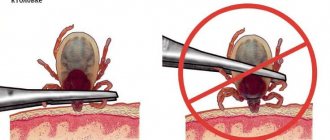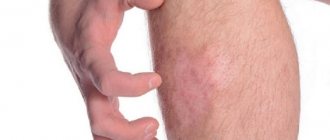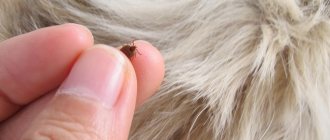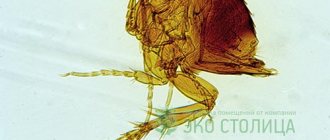Symptoms of animal infection, how to identify the parasite from a photo, why lice eaters are dangerous for cats and humans. How to treat, including traditional methods.
Cat owners take flea and tick prevention. However, they forget that lice eaters, which are no less dangerous, can also live on the body of their pets.
In this article, you will learn how to identify a lice beetle infestation and how to treat your animal without harming it.
Cat lice eaters are flightless insects about 2 millimeters in size. They have a large head, an oblong abdomen, a powerful biting apparatus, and three pairs of legs with which they cling to fur. They are yellowish in color and live on the bodies of warm-blooded animals, including cats.
The food for lice eaters are tiny particles of skin and fur, as well as dried blood.
The eggs of lice eaters are almost impossible to comb out or wash, since they are attached with a special sticky secretion, and therefore getting rid of nits is not easy.
Lice eaters are not transmitted to humans , but it is unpleasant to understand that some insects live in the house, and even more so on the body of your beloved purr, which can cause serious harm to his health.
What do lice eaters look like in cats?
Lice eaters (appearance)
Photo of a lice eater under a microscope
Scratching when affected by lice eaters
What lice eaters look like on fur
Are lice-eaters transmitted to people?
Many owners are concerned about the question: “Is it possible to get infected if the “fluffy” has tiny biting insects?” Veterinarians answer in the negative: parasites live only on the skin and fur of cats, the lack of thick hair deprives lice-eaters of a suitable habitat: harmful insects will simply freeze. There is one more point: biting parasites firmly cling to cat fur and do not like to leave the “warm place” or look for a new owner. The danger is that lice eaters carry various diseases; humans do not need contact with infectious agents.
Ways to infect cats with lice eaters
- Upon contact with a sick animal.
- From mother to kittens.
- When catching rats or mice infected with lice eaters.
- Through grooming items.
The latter method of infection is not very common, since this type of ectoparasite is drawn to warmth and will rarely linger on cool tools.
Not a single cat is immune from lice-eater infection. At risk are animals with weakened immune systems (sick, after surgery, kittens, elderly), as well as those who receive an unbalanced diet or live in uncomfortable conditions.
Lice eaters can appear in cats at any time of the year.
Causes
There can be many reasons for the appearance and ways of infection by lice eaters, among them the most common are:
- Having direct contact with an already infected animal. At the same time, a cat can pick up lice eaters not only from its relatives, but also from dogs.
- Hunting and catching infected rodents , which can also be infected with lice eaters.
- Transmission of parasites to newborn kittens from an infected mother cat.
- Poor quality of living conditions for the cat , their non-compliance with established sanitary standards.
- Increased levels of air humidity or excess dampness in rooms in which the cat spends a significant amount of time.
- Lack of complete and balanced nutrition , incorrectly selected food or poorly designed diet.
- Weakening of the immune system , which can be caused by a large number of third-party factors, including poor nutrition or previous severe forms of various diseases.
Symptoms of cat infestation with lice eaters
Lice eaters have settled on your cat's body if:
- she constantly itches, licks the fur with her tongue, tries to gnaw out an insect with her teeth;
- scratches and small blood spots, rashes, scratching, eczema, dermatitis appeared on the pet’s skin;
- bald spots appear due to hair loss;
- the cat behaves restlessly, stops obeying the owner, gets nervous for no apparent reason, ignores toys;
- sleep patterns are disrupted due to constant itching.
How can you easily distinguish lice eaters from ticks and fleas?
To do this, just hold the animal near a heat source (for example, near an incandescent lamp or an open window through which the sun shines) for several minutes. Fleas and ticks will not react to this in any way, but lice eaters will begin to actively crawl out of the depths of the fur closer to the heat source.
If your cat does have fleas, then read how to deal with them.
How dangerous are lice eaters?
Although lice eaters only cause itching, by scraping the skin, they thereby gnaw through it to a rather impressive depth. In case of severe infection in an animal:
- Wool deteriorates and falls out;
- Allergy to bites occurs;
- Dermatitis and eczema often appear;
- If lice eaters have settled for a long time and their number is already significant, anemia occurs;
- The animal loses weight, its body is literally exhausted;
- Vlaasoed is a distributor of helminths, such as cucumber tapeworms and other equally disgusting parasites.
How to treat a cat for lice
All drugs for the treatment of ectoparasites are very toxic and can harm the health of your pet.
If affected by lice eaters, it is recommended to show the cat to a veterinarian. He will make a diagnosis, select adequate treatment, establish a safe dosage of drugs and talk about caring for the animal during treatment, as well as preventive measures. If antiparasitic drugs are used incorrectly, the cat can become seriously poisoned. To prevent this, after treatment with a gel or emulsion, it is better to put a collar on the animal that prevents the drug from being licked from the body.
Your cat should be treated for lice at least twice. The first time, the drug may not have an effect on insect eggs, but will cause the death of adults and newly hatched larvae. After 10-14 days, when repeated treatment, teenage lice-eaters who have not yet had time to produce offspring will also die.
Prevention
The following preventive measures exist:
- It is necessary to avoid contact of the cat with other homeless animals;
- Regularly inspect your pet's fur;
- Keep your pet's bedding, house and slicker clean;
- Monitor your cat’s diet and provide him with enough vitamins;
- Every 2-3 months, bathe the cat, and it is advisable to use anti-parasitic shampoo;
- If the cat goes outside, then it is necessary to put an antiparasitic collar on it, which will protect it from lice eaters, as well as from fleas.
Following these simple rules will help avoid the appearance and re-infection of these parasites.
Can it be treated at home?
If the lice-eater infestation has occurred recently and the damage is minor, you can try to treat the animal at home. To do this, you should purchase drugs against ectoparasites (fleas, ticks, lice):
- pet shampoos (“Demos-Lux”, “Flea&Tick Cat Shampoo”, “Bolfo”, “Shampoo B”, “Rolf Club”, “Mr. Kiss”, “Bars”, “Clandestine”, etc.);
- drops (“Bars”, “Clandestine”, “Biafar”, “Frontline”, “Barrier”, “Hartz”, “Advantage”);
- aerosols and sprays (“Bolfo”, “Acaromectin”, “Flea & Tick – 14 Residial Spray”, “Delix-spray”, “Serco”, “Frontline”, “KiSka”).
These medications should be used with extreme caution if lice eaters are found in a kitten.
For small animals with weak immunity, you should use a lower dosage, which your veterinarian will help you choose.
Folk remedies used by animal lovers at home are not as effective as specialized drugs. However, they may well be used in the early stages of infection. For example, an animal can be bathed in a strong decoction of chamomile, string or wormwood.
Signs of parasites
It is difficult to see them with the naked eye due to their light color, but there are signs by which their presence can be determined:
- frequent itching;
- the cat is restless, sleeps poorly;
- the cat often licks its fur and tries to chew out parasites with its teeth;
- the skin on the cat’s body peels off and wounds appear;
- The hair falls out a lot, and bald patches of skin appear.
If your cat has the above symptoms, you should carefully examine him at home. Lice eaters live in cats' fur, and they stick to their eggs in such a way that it is difficult to comb them out.
In order to see these very small insects, you need good lighting. They also like warmth, and if you sit your cat near a heater, they will be easier to see because they will emerge on the ends of their fur. If you find these parasites on your pet’s skin, you should immediately take him to see a veterinarian. Only a doctor can correctly suggest a drug that will get rid of parasites and will not harm the animal.
Division into types depending on the pathogen
Symptoms and treatment for mange in cats depend on the type of mite. According to this criterion, 4 types of disease are distinguished.
Otodectosis
The causative agent is the tiny ear mite Otodectes cynotis. The maximum size of its body is only 0.75 mm. It affects the outer and inner parts of the ear. Distinctive signs of otodectosis are severe ear itching, the appearance of a nauseating smell of rot and dark grains inside the ears. An infected cat constantly shakes its head and rubs its ears against any objects.
Demodicosis
Demodex canis is a cigar-shaped parasite that is light gray in color. The length of its body is 0.2-0.3 mm. Unlike other pathogens, it lives in the sebaceous glands and hair follicles from the moment the animal is born. The development of demodicosis occurs with a sharp drop in immunity.
According to the degree of damage, there are 2 forms: localized and generalized. In the first case, the diameter of the lesions is no more than 2.5 cm, in the second, the disease affects most of the body. The localized form often goes away on its own and responds well to drug therapy. The chance of recovery from chronic demodicosis depends on the complications that arise. When a secondary infection occurs, they drop to 50%.
Depending on the symptoms, demodicosis can be scaly or pustular. In the first case, redness and cracking of the skin is noted, in the second - the appearance of suppuration and ulcers. The danger of generalized demodicosis is in the combination of scaly and pustular forms. The disease is accompanied by severe complications and is difficult to treat.
Sarcoptic mange
Sarcoptes scabiei is a broad-oval tick that is white-yellow or completely white. The length of the smallest representatives is 0.14 mm. They affect the entire surface of the body and cause sarcoptic mange. You can suspect their appearance by thin light gray lines with a small bubble at the end that appear on the affected areas.
Notoedrosis
Notoedres is a round, dirty gray parasite. The length of its body is 0.5-0.45 mm. Most often it affects the outer side of the ears. In this case, dark gray discharge with a foul odor appears from the ears. Due to liquid secretions, the fur sticks together and takes on an unkempt appearance. The disease is called pruritic scabies, or notoedrosis.
Types of ticks
The following types of ticks can parasitize an animal’s body:
- Ear. Parasites cause the disease otodectosis.
- Scabies pliers. Rarely found insects. They are carriers of sarcoptic mange.
- Cheyletiella mites. Another rare variety. An animal attacked by these parasites becomes infected with chylitis.
- Demodex cati mites provoke the development of demodicosis.
- Notoedres cati mites cause a disease called notoedrosis.
Diagnosis and treatment
If alarming symptoms are detected, you should contact a veterinary clinic. After a thorough examination, the doctor will identify the pathogen and tell you how to treat scabies in a cat.
Making a diagnosis and prescribing medications
During diagnosis, the veterinarian collects anamnesis and conducts an external examination of the caudate patient. To determine the pathogen, microscopic examination of skin scrapings is used. This allows you to exclude diseases with similar symptoms: dermatitis, lichen, eczema and allergies.
The duration of drug therapy depends on the condition of the cat and the degree of skin damage. On average, its duration is 1-3 weeks. The drugs used are divided into injection (solutions for intramuscular and intravenous injections) and external (ointments, medicated shampoos, drops).
How to treat scabies mites in a cat directly depends on the diagnosis. The list of required medications includes:
- antiseptics (chlorhexidine, hydrogen peroxide) used to clean the affected surface;
- acaricides aimed at combating ticks;
- antibiotics that destroy secondary infections;
- antihistamines, relieving itching and irritation;
- immunomodulators and vitamin complexes that stimulate the functioning of immune cells.
The main emphasis is on antiparasitic treatment. The choice of drug is individual. All dosages are determined by the doctor. The most popular acaricidal agents include:
1. Amitrazine
. Solution for external use with a cumulative effect. It treats scabies mites in cats of all types and forms, relieves pain and softens the skin. Amitrazine is applied 2-5 times a day with a mandatory break of a week. This scheme helps maintain immunity against the pathogen after use.
2. Ivermectin
. An injection solution that affects all types of scabies mites. The period of its use is only 7 days. Due to the rather aggressive effects on the body, it is important to strictly follow the recommended dosages. Ivermectin is not suitable for kittens.
3. Sulfur ointment
. An inexpensive and accessible product that destroys larvae and adults. The ointment has no direct effect on laid eggs. Their destruction is possible only after hatching, so the duration of treatment is maximum. The treatment is carried out 2 times a day, applying a thin layer of ointment to the affected areas.
4. Aversectin ointment
. Another drug that affects all forms of the pathogen. The dosage regimen is similar to Amitrazine. To apply the ointment, use a special spatula.
5. Lawyer
. Single-use drops are suitable for controlling ticks, helminths and fleas.
The effectiveness of therapy depends on the regularity of the recommended procedures. Even a single missed application of a remedy can delay recovery for an unknown period.
How to care for an animal at home
After diagnosis, it is necessary to isolate the patient from people and other pets. Boil, treat with special means or take out into the cold all things that the sick cat has come into contact with.
Before treating with medicinal products, wash the infected animal with veterinary shampoo. This is necessary to get rid of dead epidermis, fallen hairs and dried blood. The hair on the affected areas is cut off after drying. This facilitates subsequent treatment with ointments and solutions. It is recommended to ensure that you have a protective collar in advance. It will protect against licking off medications and new damage.
To clean the ears, use cotton pads soaked in sunflower oil or plain water. After treating all affected areas, follow your veterinarian's instructions. Remember that using cotton swabs is dangerous: they can injure the eardrum and damage your furry pet’s hearing. It is also prohibited to apply several drugs at the same time. This may lead to an allergic reaction or other side effects. To be safe, take 15-minute breaks.
In consultation with a veterinarian, the use of folk remedies is permissible. They are easy to prepare at home. Before use, be sure to test a small amount of the product on your skin to rule out an allergic reaction. Popular folk remedies include:
- Sulfur soap
. It is used once during the first bath. Sulfur has antifungal and antibacterial properties.
- White vinegar
. Spray the coat with vinegar solution twice a day for 2 weeks. Avoid contact with open wounds. Vinegar is very irritating to the skin.
- Bay leaf
. Grind the bay leaf along with the melted butter in a blender. Apply the resulting ointment to the wounds twice a day for 1-2 weeks.
- Essential oils
. To relieve swelling and irritation, rub a few drops of lavender or almond oil into the affected areas. Repeat the procedure twice a day for 2-3 weeks wearing protective gloves.
- Boric acid
. Treat the affected ears with the solution every week until complete recovery.
- Buckthorn bark
. Grind 2 tbsp. l. leaves and pour a glass of boiling water. Keep the solution in a water bath for 15 minutes, then strain and cool to room temperature. Rub the resulting solution into your skin twice a day for 2 weeks.
When using the listed products, avoid contact with mucous membranes. This can cause severe burning or burns.
Remember that during home quarantine all pets will need diagnostics. If the diagnosis is positive, they are prescribed similar treatment; if the diagnosis is negative, the use of acaricidal collars and drops on the withers will be sufficient.
It must be remembered that treatment of scabies in cats at home should be carried out strictly according to the regimen prescribed by the veterinarian. In addition, it will not be possible to carry out the therapy completely on your own - to determine recovery, you will need to take a scraping and analyze it. Such diagnostics are only possible in a clinic.
Is it possible to get infected from animals?
This type of parasitic organism is not believed to be transmitted to humans. However, when examining a sick animal, it is still recommended to wear gloves. The disease is contagious to almost all mammals, but a person cannot become infected with subcutaneous mites from a cat.
When a tick gets on the epidermis of a pet owner, it dies. It is worth noting that there are still cases when demodicosis can be transmitted to a person from a sick animal and people become infected with this parasitic disease. In case of inflammatory processes in the body and chronic diseases, subcutaneous mites can also be dangerous for humans.
Learn about other types of ticks on cats >>>
Consequences
- Dog's sense of smell
- Maine Coon
- Domestic iguana
- How much does a raccoon cost?
- Interesting facts about cats
- Cute dog breeds
A cat's lice eater can cause a whole series of negative consequences for the animal's health. This is especially acute in cases where treatment is ignored or carried out incorrectly. The following problems are possible: infection with tapeworms, hemobartonellosis and other diseases that lice eaters carry; acute allergic reactions, dermatitis, phlegmon and swelling in cats with sensitive skin; infectious and invasive diseases, fungi, subcutaneous mites, which easily appear on inflamed and wounded skin; hair loss and baldness; general exhaustion and anemia; exacerbation of chronic diseases.
Complications
If you do not respond to the symptoms of the disease in time, the disease can lead to complications.
What are the consequences of ignoring treatment?
- abscesses of hair follicles;
- intoxication of the body;
- weakened immunity;
- slowing down metabolism;
- deterioration of apatite;
- disruption of the sebaceous glands;
In addition, if the subcutaneous mite from a cat is not removed in time, tissue necrosis with signs of rotting occurs at a late stage.











